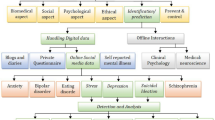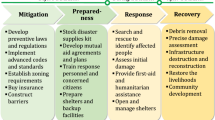Abstract
Risk prediction and damage assessment play critical roles in disaster response to reduce losses. Social media can serve as crowdsourcing platforms for disaster information dissemination and data mining. Using typhoon Haiyan as an example, a close relationship between social media and disaster damage estimation is demonstrated, which provides a new perspective for disaster preparedness and response. Based on disaster-related social media data, a new index model is developed for situation awareness and damage assessment before, during, and after disasters. The difference between the new index model and traditional ones is that the new index is extracted from microblogs using semantic analysis method. The score of each index is determined by the emergency management experts. The weight is calculated based on TF-IDF method, a classical term frequency weight method. Based on the new index model, quantitative assessment is added to qualitative analysis. The assessment result is consistent with actual situation, which underlines the feasibility of implementation of the new model.





Similar content being viewed by others
References
Abdelhaq H, Sengstock C, Gertz M (2013) Eventweet: online localized event detection from twitter. Proc VLDB Endow 6(12):1326–1329. doi:10.14778/2536274.2536307
Abel F, Hauff C, Houben GJ et al (2012) Twitcident: fighting fire with information from social web streams. Proceedings of the 21st international conference companion on World Wide Web. ACM, pp 305–308. doi:10.1145/2187980.2188035
Bakshy E, Rosenn I, Marlow C et al (2012) The role of social networks in information diffusion. Proceedings of the 21st international conference on World Wide Web. ACM, pp 519–528. doi:10.1145/2187836.2187907
Chan CJ (2014) Crowdsourcing Disaster Response. ResearchGate
Chen G, Xiao L (2016) Selecting publication keywords for domain analysis in bibliometrics: a comparison of three methods. J Informetr 10(1):212–223. doi:10.1016/j.joi.2016.01.006
Chen S, Zhang H, Lin M et al (2011) Comparision of microblogging service between Sina Weibo and Twitter. Computer science and network technology (ICCSNT), 2011 international conference on. IEEE, vol 4, pp 2259–2263. doi:10.1109/ICCSNT.2011.6182424
Correa T, Hinsley AW, De Zuniga HG (2010) Who interacts on the Web? The intersection of users’ personality and social media use. Comput Hum Behav 26(2):247–253. doi:10.1016/j.chb.2009.09.003
Couling M (2014) Tsunami risk perception and preparedness on the east coast of New Zealand during the 2009 Samoan Tsunami warning. Nat Hazards 71(1):973–986. doi:10.1007/s11069-013-0945-y
Demirbas M, Bayir MA, Akcora CG et al (2010) Crowd-sourced sensing and collaboration using twitter. World of wireless mobile and multimedia networks (WoWMoM), 2010 IEEE international symposium on a. IEEE, pp 1–9. doi:10.1109/WOWMOM.2010.5534910
Doan A, Ramakrishnan R, Halevy AY (2011) Crowdsourcing systems on the world-wide web. Commun ACM 54(4):86–96. doi:10.1145/1924421.1924442
Eskenazi M, Levow GA, Meng H et al (2013) Crowdsourcing for speech processing: applications to data collection, transcription and assessment. Wiley
Estellés-Arolas E, González-Ladrón-de-Guevara F (2012) Towards an integrated crowdsourcing definition. J Inf Sci 38(2):189–200. doi:10.1177/0165551512437638
Forman G (2008) BNS feature scaling: an improved representation over tf-idf for svm text classification. Proceedings of the 17th ACM conference on Information and knowledge management. ACM, pp 263–270. doi:10.1145/1458082.1458119
Gao H, Barbier G, Goolsby R et al (2011a) Harnessing the crowdsourcing power of social media for disaster relief. Arizona State University, Tempe
Gao H, Wang X, Barbier G et al (2011) Promoting coordination for disaster relief—from crowdsourcing to coordination. Social computing, behavioral-cultural modeling and prediction. Springer Berlin Heidelberg, pp 197–204. doi:10.1007/978-3-642-19656-0_29
Gao Q, Abel F, Houben G J et al (2012) A comparative study of users’ microblogging behavior on Sina Weibo and Twitter. User modeling, adaptation, and personalization. Springer Berlin Heidelberg, pp 88–101. doi:10.1007/978-3-642-31454-4_8
Guan XY, Chen C (2014) Using social media data to understand and assess disasters. Nat Hazards 74:837–850. doi:10.1007/s11069-014-1217-1
Guan W, Gao H, Yang M et al (2014) Analyzing user behavior of the micro-blogging website Sina Weibo during hot social events. Physica A 395:340–351. doi:10.1016/j.physa.2013.09.059
Lan YX (2011) On Construction of Emergency Network Safety Evaluation Index System. J Intell 7:019 (in Chinese)
Ma Y, Deng Q, Wang X et al (2014) Keyword-based semantic analysis of microblog for public opinion study in online collective behaviors. Web-age information management. Springer International Publishing, pp 44–55. doi:10.1007/978-3-319-11538-2_5
Merchant RM, Elmer S, Lurie N (2011) Integrating social media into emergency-preparedness efforts. N Engl J Med 365(4):289–291. doi:10.1056/NEJMp1103591
Morchid M, Dufour R, Bousquet PM et al (2014) Feature selection using principal component analysis for massive retweet detection. Pattern Recogn Lett 49:33–39. doi:10.1016/j.patrec.2014.05.020
Pennington-Gray L, Kaplanidou K, Schroeder A (2013) Drivers of social media use among African Americans in the event of a crisis. Nat Hazards 66(1):77–95. doi:10.1007/s11069-012-0101-0
Qu Y, Huang C, Zhang P et al (2011) Microblogging after a major disaster in China: a case study of the 2010 Yushu earthquake. Proceedings of the ACM 2011 conference on Computer supported cooperative work. ACM, pp 25–34. doi:10.1145/1958824.1958830
Ramos J (2003) Using tf-idf to determine word relevance in document queries. Proceedings of the first instructional conference on machine learning
Rudat A, Buder J, Hesse FW (2014) Audience design in Twitter: retweeting behavior between informational value and followers’ interests. Comput Hum Behav 35:132–139. doi:10.1016/j.chb.2014.03.006
Sakaki T, Okazaki M, Matsuo Y (2010) Earthquake shakes Twitter users: real-time event detection by social sensors. Proceedings of the 19th international conference on World Wide Web. ACM, pp 851–860. doi:10.1145/1772690.1772777
Salton G, Buckley C (1988) Term-weighting approaches in automatic text retrieval. Inf Process Manage 24(5):513–523. doi:10.1016/0306-4573(88)90021-0
Spiro E, Irvine C, DuBois C, Butts C (2012) Waiting for a retweet: modeling waiting times in information propagation. In: 2012 NIPS workshop of social networks and social media conference. Accessed 12 Dec 2012
Starbird K, Palen L (2012) Pass it on? Retweeting in mass emergencies. In: Proceedings of conference on information systems on crisis response and management (ISCRAM 2010). Accessed Dec 12 2012
Starbird K, Palen L, Hughes AL et al (2010) Chatter on the red: what hazards threat reveals about the social life of microblogged information. Proceedings of the 2010 ACM conference on Computer supported cooperative work. ACM, pp 241–250. doi:10.1145/1718918.1718965
Stieglitz S, Dang-Xuan L (2013) Emotions and information diffusion in social media—Sentiment of microblogs and sharing behavior. J Manage Inf Syst 29(4):217–248. doi:10.2753/MIS0742-1222290408
Tian YL, Yang Q (2008) Urban Disaster Response Capacity Evaluation Index system model design based on AHP-DELPHI method. WUHAN LIGONG DAXUE XUEBAO JIAOTONG KEXUE YU GIONGCHENG BAN 32(1):168 (in Chinese)
Xie X, Du X, Yang Q et al (2015) A study on process model of computing similarity between product features and online reviews. Big data technology and applications. Springer, Singapore, pp 298–308. doi:10.1007/978-981-10-0457-5_27
Xiong XB, Zhou G, Huang YZ et al (2013) Dynamic evolution of collective emotions in social networks: a case study of Sina weibo. Sci China Inf Sci 56(7):1–18. doi:10.1007/s11432-013-4892-8
Yates D, Paquette S (2011) Emergency knowledge management and social media technologies: a case study of the 2010 Haitian earthquake. Int J Inf Manage 31:6–13. doi:10.1016/j.ijinfomgt.2010.10.001
Yin J, Lampert A, Cameron M et al (2012) Using social media to enhance emergency situation awareness. IEEE Intell Syst 27(6):52–59
Zaman TR, Herbrich R, Van Gael J et al (2010) Predicting information spreading in twitter. Workshop on computational social science and the wisdom of crowds, nips. vol 104, no 45, pp 17599–601
Zhao WW, Zhang JH, Shang JF et al (2008) Power system large scale blackout emergency evaluation index system and its application. Autom Electr Power Syst 32(20):27–30 (in Chinese)
Acknowledgments
This work was partially supported by the National Natural Science Foundation of China (Grant No. 91224008). We thank the Beijing Key Laboratory of Intelligent Telecommunications Software and Multimedia at Beijing University of Posts and Telecommunications for providing the microblog data support. We also thank the reviewers and editors for their careful review and helpful suggestions.
Author information
Authors and Affiliations
Corresponding author
Rights and permissions
About this article
Cite this article
Deng, Q., Liu, Y., Zhang, H. et al. A new crowdsourcing model to assess disaster using microblog data in typhoon Haiyan. Nat Hazards 84, 1241–1256 (2016). https://doi.org/10.1007/s11069-016-2484-9
Received:
Accepted:
Published:
Issue Date:
DOI: https://doi.org/10.1007/s11069-016-2484-9




